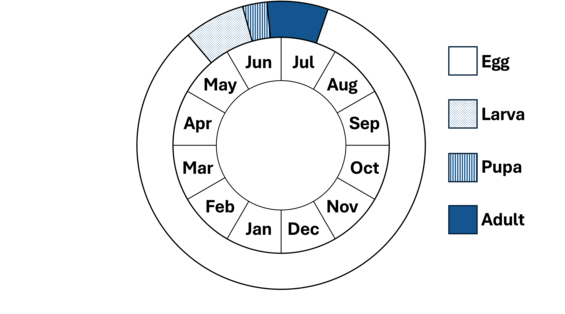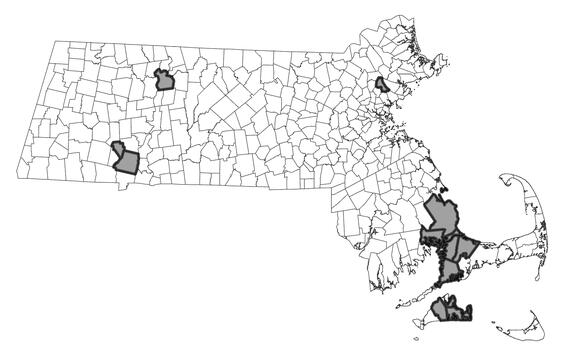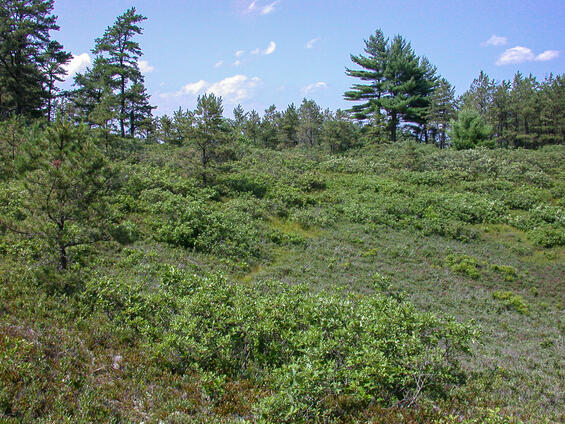- Scientific name: Macaria exonerata
- Species of Greatest Conservation Need (MA State Wildlife Action Plan)
- Special Concern (MA Endangered Species Act)
Description
The pine barrens macaria (Macaria exonerata) is a geometrid moth with a forewing length of 11-13 mm (0.4-0.5 in; Ferguson 2008). The forewing is pale grayish-brown in color, peppered with dark brown to black scales, and with faint brown postmedial, median, and antemedial lines, all of which may be obscure in some (particularly worn) individuals. The postmedial, median, and antemedial lines tend to be slightly darker and more pronounced in the female as compared to the male. The hind wing is pale yellow, speckled with brown; in some individuals (particularly females) the brown speckling may be more pronounced and concentrated to form a postmedial line, median line, and discal spot. The discal spot is typically present in the male but may be obscure. The head is brownish-orange in color, the thorax concolorous with the grayish-brown of the forewings, and the abdomen tan. The male sulphur angle moth (Macaria sulphurea) is similar to the male pine barrens macaria; however, the forewing of the former is more evenly colored, typically without lines, or with only a faint and incomplete postmedial line.


Pine Barrens Macaria, Macaria exonerata. Left: male. Right: female.
Life cycle and behavior

In Massachusetts, adult pine barrens macaria moths fly from mid-June through mid-July, with stragglers into late July. Eggs overwinter and hatch in early spring. Larvae feed on catkins and new leaves of scrub oak (Quercus ilicifolia), completing development and pupating by early June (Nelson 2015).
Distribution and abundance
The range of the pine barrens macaria extends along the Atlantic Coastal Plain from southern Maine south to New Jersey, and in the Appalachian Mountains from New York and Pennsylvania south to West Virginia and Virginia (Schweitzer et al. 2011). In Massachusetts, the pine barrens macaria occurs in the Connecticut River Valley, in the northeastern part of the state, and in the southeastern part of the state including Plymouth, Cape Cod, and Martha’s Vineyard.

Distribution in Massachusetts.
2000-2025
Based on records in the Natural Heritage Database.
Habitat
In Massachusetts, the pine barrens macaria inhabits pitch pine-scrub oak barrens on sandplains and rocky summits and ridges.
Healthy habitats are vital for supporting native wildlife and plants. Explore habitats and learn about conservation and restoration in Massachusetts.

Sandplain pitch pine-scrub oak barrens habitat with sparse trees and abundant scrub oak, ideal habitat for the pine barrens macaria. Habitat managed by DCR and MassWildlife at Myles Standish State Forest.
Threats
The pine barrens macaria is threatened by habitat loss and fire suppression in its disturbance-dependent habitats, in particular sandplain and ridgetop pitch pine-scrub oak barrens. Other potential threats include introduced generalist parasitoids, aerial insecticide spraying, non-target herbicide application, and off-road vehicles. The effect of a warming climate may not be detrimental to this species in Massachusetts; its range extends south to Virginia, suggesting adaptation to warm temperatures.
Conservation
Land protection and habitat management are the primary conservation needs of this species in Massachusetts. In particular, sandplain and ridgetop pitch pine-scrub oak barrens should be conserved, restored, and managed to maintain habitat for this species and the entire suite of rare and threatened species dependent on such habitat.
Survey and monitoring
The distribution of the pine barrens macaria in sandplain and ridgetop pitch pine-scrub oak barrens is well documented. Known populations of this species should be surveyed to document persistence at least once every 25 years; every 10 years is more desirable when practicable.
Management
Management of sandplain and ridgetop pitch pine-scrub oak barrens benefits a suite of rare and threatened species, and habitat condition should be monitored and management adapted as needed. For the pine barrens macaria, open barrens with a shrub layer including scrub oak (Quercus ilicifolia) is of particular importance.
Research needs
The natural history and conservation needs of the pine barrens macaria are relatively well known. However, as with other species with a geographic range mostly south of Massachusetts, the future effects of a warming climate on this species are unpredictable and should be documented.
References
Ferguson, D.C. 2008. Geometroidea, Geometridae (part): Ennominae (part): Abraxini, Cassymini, Macariini. Fascicle 17.2. 431 pp. in: Hodges, R.W. (ed.). The Moths of North America. Allen Press, Lawrence, Kansas.
Nelson, M.W. 2015. The life history of Speranza exonerata Ferguson, 2008 (Geometridae: Ennominae: Macariini). Journal of the Lepidopterists’ Society 69(2): 1-6.
Schweitzer, D.F., M.C. Minno, and D.L. Wagner. 2011. Rare, Declining, and Poorly Known Butterflies and Moths (Lepidoptera) of Forests and Woodlands in the Eastern United States. Forest Service, U.S. Dept. of Agriculture, Washington, DC. 517 pp.
Contact
| Date published: | March 7, 2025 |
|---|